Today, we’re diving deep into the captivating world of Java ferns and uncovering the secrets of how to attach these stunning plants. Prepare yourself for a visual feast as we explore the wonders of Microsorum pteropus – the Java fern.
Imagine a verdant, emerald fern gliding effortlessly through the water, providing a haven for tiny fish and infusing your tank with an air of sophistication. But here’s the burning question: how on earth do you actually attach one of these beauties?
In this guide, we’ll take you by the hand and lead you through each step of attaching a Java fern.
Get ready to soak up all the essential knowledge you need to transform your aquarium into an underwater oasis that will make all your fishy friends green with envy.
Overview of Java Ferns
Contents
- 1 Overview of Java Ferns
- 2 Tying Java Ferns to Driftwood or Rocks
- 3 Using Gel-Based Super Glue for Attachment
- 4 Wedging the Rhizome between Crevices in Rocks or Driftwood
- 5 Floating Java Ferns in the Water Column
- 6 Considerations when Choosing a Substrate for Attachment
- 7 Benefits of Attaching Java Ferns
- 8 Maintenance Tips for Java Ferns
- 9 Conclusion
Step into the captivating world of aquariums, where live plants not only elevate the beauty of the underwater realm but also provide a host of benefits for the fish and overall ecosystem. Among the array of plant options, one stands out as a versatile and enchanting choice – the Java Fern. Join us as we explore the unique characteristics of Java Ferns, unravel their benefits, and delve into the requirements for aquarium owners.
Unique Appearance:
In the lush landscapes of Southeast Asia, Java Ferns, belonging to the Microsorum genus, reign supreme. With long, slender leaves that grow in a mesmerizing rosette pattern, these ferns effortlessly captivate onlookers.
Their dark green coloration, coupled with leaf shapes and sizes that vary like nature’s brushstrokes, ensures that Java Ferns become striking focal points in any aquarium.
Attachment Methods:
Unlike their aquatic counterparts, Java Ferns possess a secret attachment method. These marvels do not demand planting in substrate; instead, they cling to objects within the aquarium such as rocks, driftwood, or other decorations.
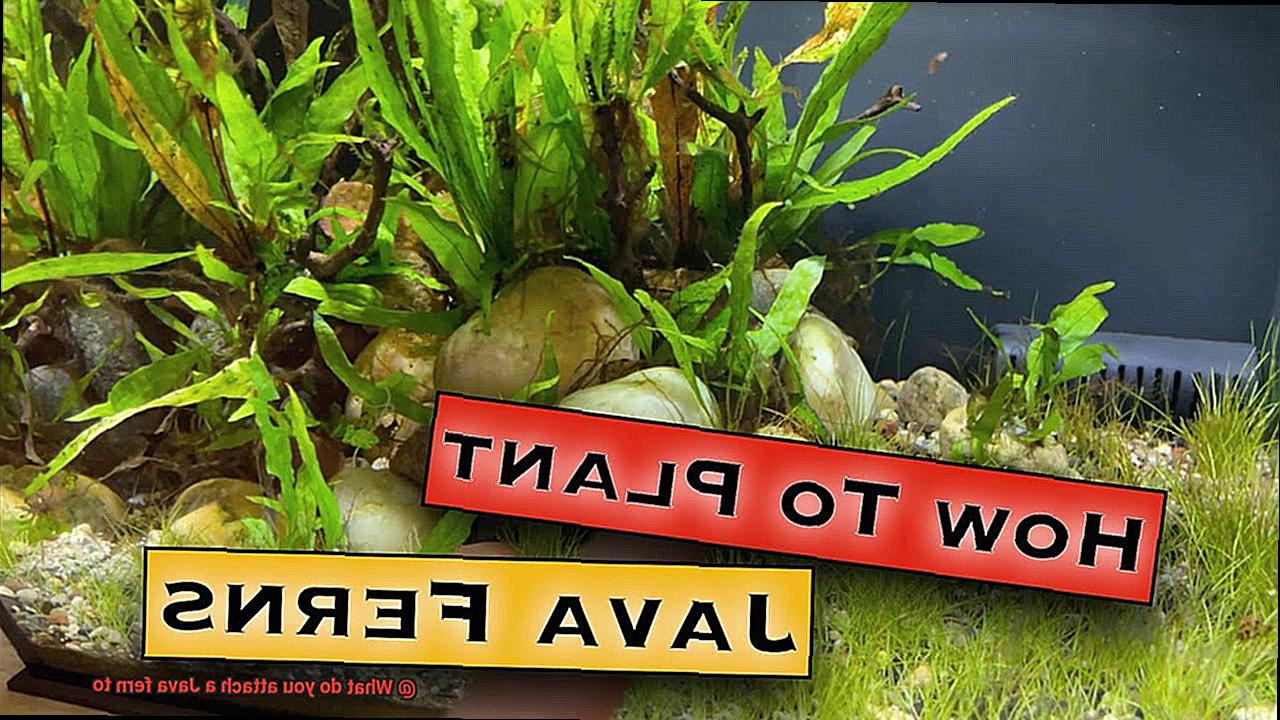
The ferns can be secured by tying them with fishing line or using plant-safe glue. This ingenious strategy keeps them firmly grounded, preventing unruly fish or turbulent currents from dislodging them.
Versatile Placement Options:
Java Ferns embrace versatility by attaching themselves to various materials, including porous surfaces like lava rock or coconut shells. This not only provides additional attachment points but also amplifies the aesthetic allure of the aquarium.
Furthermore, these ferns can be effortlessly detached and rearranged at will, granting aquarium enthusiasts boundless creativity in designing their aquatic utopias.
Aquarium Compatibility:
Embracing adaptability with open fronds, Java Ferns thrive equally in freshwater and brackish water tanks. Their inherent compatibility extends to various fish species, making them an ideal addition to any aquarium setup.
Whether your tank houses vibrant tropical fish or tranquil brackish water dwellers, Java Ferns harmoniously coexist, adding an extra layer of visual splendor.
Low Maintenance Requirements:
In the realm of plant care, Java Ferns reign as undemanding monarchs. They gracefully flourish under low to moderate light levels, making them perfect for aquariums with limited illumination. Thriving in slightly acidic to neutral water (pH 6-7.5), these ferns adapt to a wide range of aquatic environments, catering to aquarium owners’ preferences.
Regular pruning and removal of deceased leaves, coupled with nutrient supplementation, ensure that Java Ferns maintain their vibrant growth and overall health.
Tying Java Ferns to Driftwood or Rocks
Then it’s time to dive into the enchanting world of tying Java Ferns to driftwood or rocks. This simple technique will enhance the aesthetics of your tank and provide a natural backdrop for your aquatic inhabitants. So, grab your thread or fishing line and let’s get started.
First things first, before we begin tying Java Ferns to driftwood or rocks, it’s important to ensure that these materials are clean and free from any contaminants that could harm your precious plants.
Soak the driftwood in water for a few days to remove any tannins or chemicals that may leach into your aquarium. Give those rocks a thorough rinse to eliminate any dirt or debris that could interfere with the attachment process.
Now that our materials are clean, let’s talk about what you’ll need for this project. You’ll want to use a non-toxic thread or fishing line that won’t harm your plants or fish. Opt for cotton thread or nylon fishing line, as they are excellent options that will securely hold your Java Ferns without causing any harm.
Once you have your materials ready, it’s time to select a healthy Java Fern with strong roots. Gently remove any excess leaves or dead portions of the plant to promote healthy growth. Now, take your Java Fern and position it on the driftwood or rock where you want it to be attached.
Here comes the fun part – tying. Take your thread or fishing line and wrap it around the base of the plant, ensuring that it is secure but not too tight as to damage the plant. Now, continue wrapping the thread or fishing line around the driftwood or rock, making several loops around different parts of the plant to ensure stability.
As you securely tie your Java Fern, trim any excess thread or fishing line so that it doesn’t detract from the overall appearance of your planted decoration. Now, sit back and admire your handiwork.
Remember, Java Ferns are slow-growing plants, so be patient as they establish themselves on the driftwood or rocks. Avoid disturbing the plant by moving or repositioning it frequently. With proper care and regular maintenance, your Java Ferns will thrive and provide a beautiful addition to your aquarium.

Using Gel-Based Super Glue for Attachment
Look no further than the enchanting power of gel-based super glue for attaching your cherished Java ferns. In this blog post, we will dive deep into the captivating process of using this adhesive wonder and unlock the secrets to a successful attachment. So sit back, grab your favorite beverage, and prepare to be amazed.
Aquarium-Safe Gel-Based Super Glue:
Bid farewell to worries about harmful chemicals or toxins endangering your aquatic companions. Gel-based super glue designed specifically for aquarium use is meticulously formulated to ensure the utmost safety for your tank’s inhabitants. Opt for a brand that explicitly states its suitability for aquariums, guaranteeing a swim of tranquility for all.
Preparing the Surface:
Just as a pristine canvas enhances an artist’s masterpiece, a spotless surface sets the stage for an unyielding bond. Prior to application, ensure that the surface where you plan to attach your Java fern is devoid of dirt, algae, or debris. A gentle scrub with an aquarium-safe brush or sponge will cleanse away any hindrances.
Applying the Glue:
Now it’s time to get our hands delightfully sticky. Squeeze a small amount of gel-based super glue onto either a clean surface or directly onto the roots of your Java fern. Applying it to the roots guarantees superior adhesion, so don’t shy away from getting up close and personal with those captivating roots. Remember, moderation is key – excessive glue can mar the beauty and pose potential harm to your plant.
Attaching the Java Fern:
The moment of truth has arrived – attaching your Java fern to its new abode. With great care, position the plant onto the desired surface and press it firmly against it for a few seconds. This allows the glue to weave its magic and establish an unyielding bond. Exercise caution to prevent any inadvertent harm to the plant.
Curing Time:
Patience, my friends, is the secret ingredient to success. After attaching your Java fern, resist the temptation to immediately submerge it in water. Adhere to the manufacturer’s instructions regarding the recommended curing time. Typically, gel-based super glue cures within minutes to hours, ensuring a bond of unparalleled strength. Embrace this waiting game for a connection that endures.
Monitoring and Maintenance:
Your Java fern is now securely attached, but our journey continues. Keep a watchful eye on the plant’s growth and overall health. Should any signs of detachment or looseness arise, fear not.
Reapply the gel-based super glue as needed. Remember to maintain optimal water parameters and lighting conditions, crafting an environment ideal for your Java fern’s flourishing.
Wedging the Rhizome between Crevices in Rocks or Driftwood
Take your aquascaping skills to the next level and create a captivating underwater oasis that will leave your friends and family in awe. Enter the enchanting world of wedging the rhizome of Java ferns between crevices in rocks or driftwood.
Java ferns, also known as Microsorum pteropus, are beloved by aquarium enthusiasts for their hardiness and unique appearance.
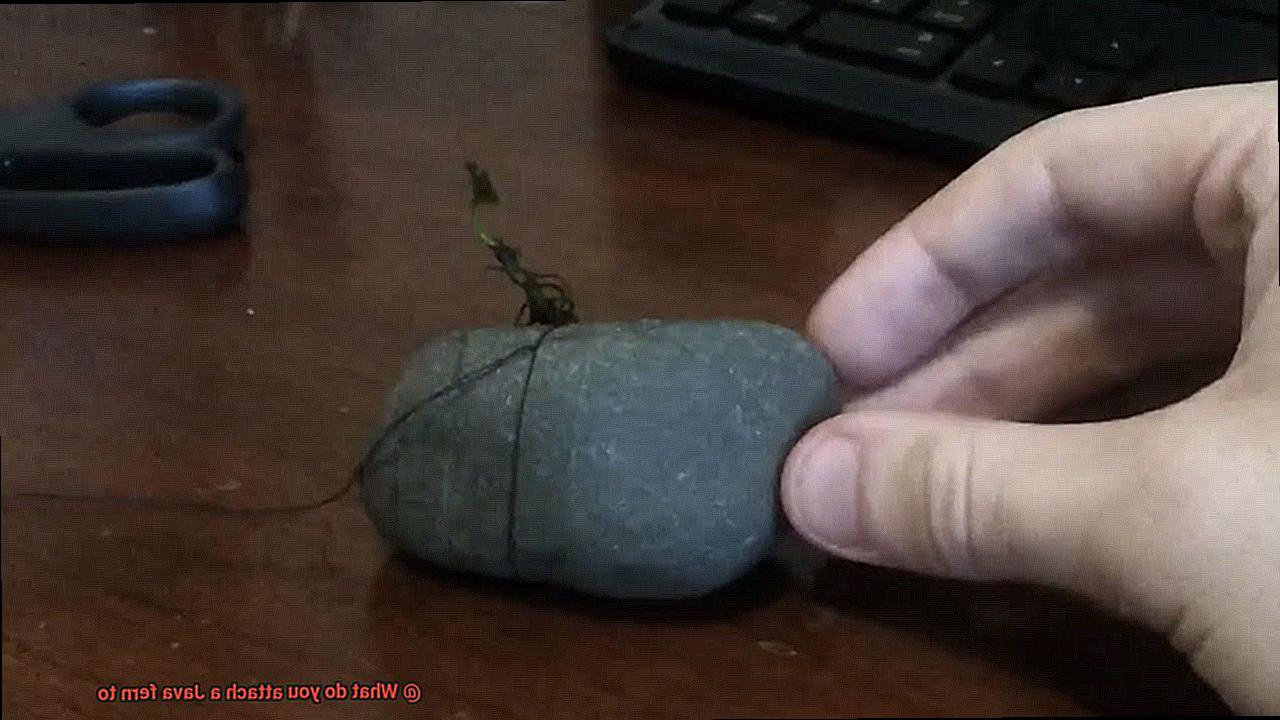
And what better way to showcase these magnificent plants than by securely attaching them to rocks or driftwood in your aquascape?
Let’s dive into the process of wedging the rhizome between crevices in rocks or driftwood:
- Selecting the perfect piece: Choose rocks or driftwood with suitable crevices or gaps where the rhizome can be securely wedged. Opt for rough surfaces on rocks or natural grooves and crevices in driftwood. Smooth surfaces won’t provide enough grip for your Java fern to stay in place.
- Prep work: Thoroughly clean your chosen rock or driftwood piece to remove dirt, debris, and potential contaminants. A clean canvas is essential for successful attachment.
- Finding the right spot: Examine your rock or driftwood carefully and identify a suitable crevice where the rhizome can be placed. Choose a location that allows the fern’s leaves to spread out naturally without overlapping or being cramped.
- Insertion time: Gently insert the rhizome into the chosen crevice, ensuring it is securely wedged in place. Don’t apply excessive force that could damage the plant.
- Positioning matters: Crucially, position your Java fern at the right depth. Placing it too deep may hinder growth and limit light access, while positioning it too high may cause drying out or detachment.
- Patience is key: Monitor your fern’s growth and make adjustments if necessary. Over time, the plant may expand and require repositioning or securing to prevent dislodgement.
By wedging the rhizome between crevices in rocks or driftwood, you’re providing a natural and visually appealing method of attaching your Java ferns in your aquarium. This creates a stunning aquascape while allowing the plant to mimic its natural habitat and receive adequate water flow and nutrients for healthy growth.
Floating Java Ferns in the Water Column
Looking to add a touch of natural beauty to your aquarium? Consider floating Java ferns in the water column. These plants are renowned for their unique foliage and ability to thrive in low-light conditions, creating a stunning visual effect as they sway with the water’s gentle movement.
Let’s dive deeper into the benefits and challenges of floating Java ferns, along with some tips for successfully incorporating them into your aquatic setup.
Benefits:
- Visual appeal: Floating Java ferns bring a sense of naturalness and beauty to your aquarium. The mesmerizing swaying motion they create with the water current is captivating.
- Versatility: By floating Java ferns, you have more flexibility in designing your aquascape. You can position them in areas where attaching them to rocks or driftwood would be challenging, such as under floating plants or amidst dense vegetation.
Challenges:
- Lighting requirements: While Java ferns are low-light plants, it’s important to consider their lighting needs when floating them. Place them in shaded areas of the tank, away from direct light sources.
- Maintenance: Regular maintenance is necessary when floating Java ferns. The plant may grow new leaves or produce small plantlets over time. Gently separate these from the parent plant and either attach them to driftwood or rocks or let them float freely in the water.
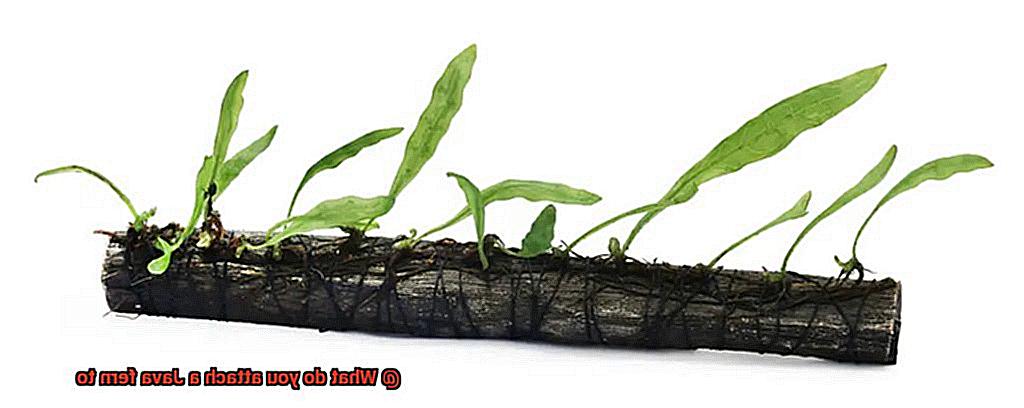
Tips for Success:
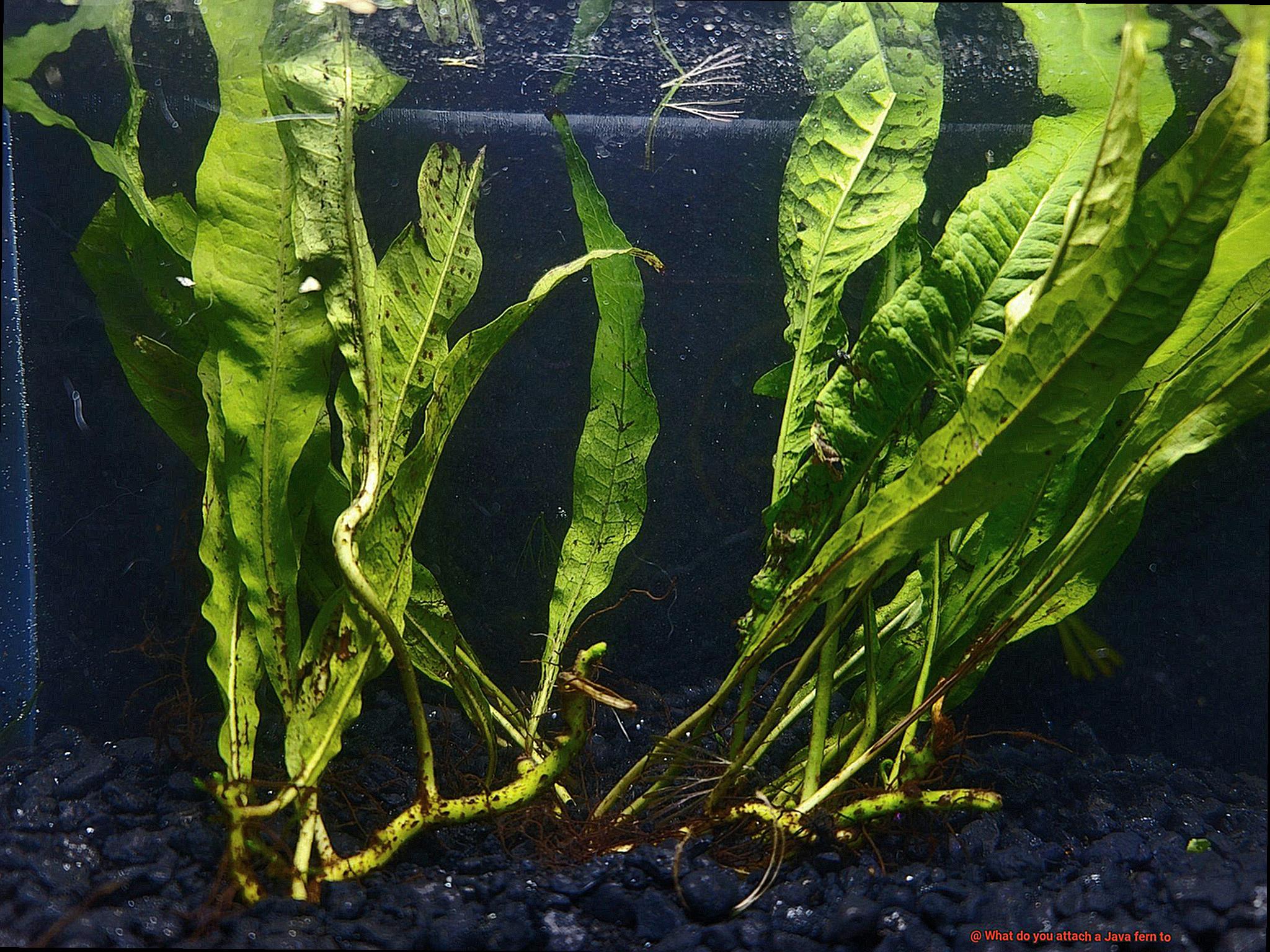
- Floating materials: Use a floating plant ring made of foam or plastic to contain the Java fern within a designated area on the water’s surface. Alternatively, attach the plant to a small piece of Styrofoam or cork using fishing line or nylon thread.
- Natural materials: Avoid using adhesives or glues when attaching Java ferns to floating materials, as these can harm the plant. Opt for safe, natural materials suitable for aquarium use.
- Nutrient supplementation: Floating Java ferns may require additional nutrients to thrive. Consider supplementing the water column with liquid fertilizers or root tabs to provide the necessary nutrients for healthy growth.
- Growth limitations: Floating Java ferns may not grow as well as when attached to a solid surface. The floating method may limit their access to nutrients, resulting in slower growth or smaller leaves.
Considerations when Choosing a Substrate for Attachment
If you’re seeking to add elegance and natural beauty to your aquarium or terrarium, the Java fern is an excellent choice. These graceful plants thrive in low-light conditions, making them popular among aquatic plant enthusiasts.
To ensure the health and long-term attachment of your Java fern, choosing the right substrate is crucial. In this guide, we will explore the key considerations when selecting a substrate for attaching your Java fern.
Compatibility with Java fern:
Porosity:
- Opt for porous substrates such as lava rock, porous rocks, or coconut fiber.
- Porous substrates provide a surface for the plant to anchor its roots and allow water and nutrients to flow freely for optimal growth.
Stability:
- Select stable substrates like gravel, sand, or clay-based materials.
- Avoid loose or unstable substrates that may cause the plant to detach easily.
- Java ferns require a substrate that firmly holds their delicate and elongated roots in place.
Nutrient content:
- While Java ferns are not heavy feeders, choose a substrate that offers some nutrients.
- Look for substrates containing essential nutrients like iron, potassium, and trace elements.
- These nutrients promote healthy foliage and vibrant growth in your Java ferns.
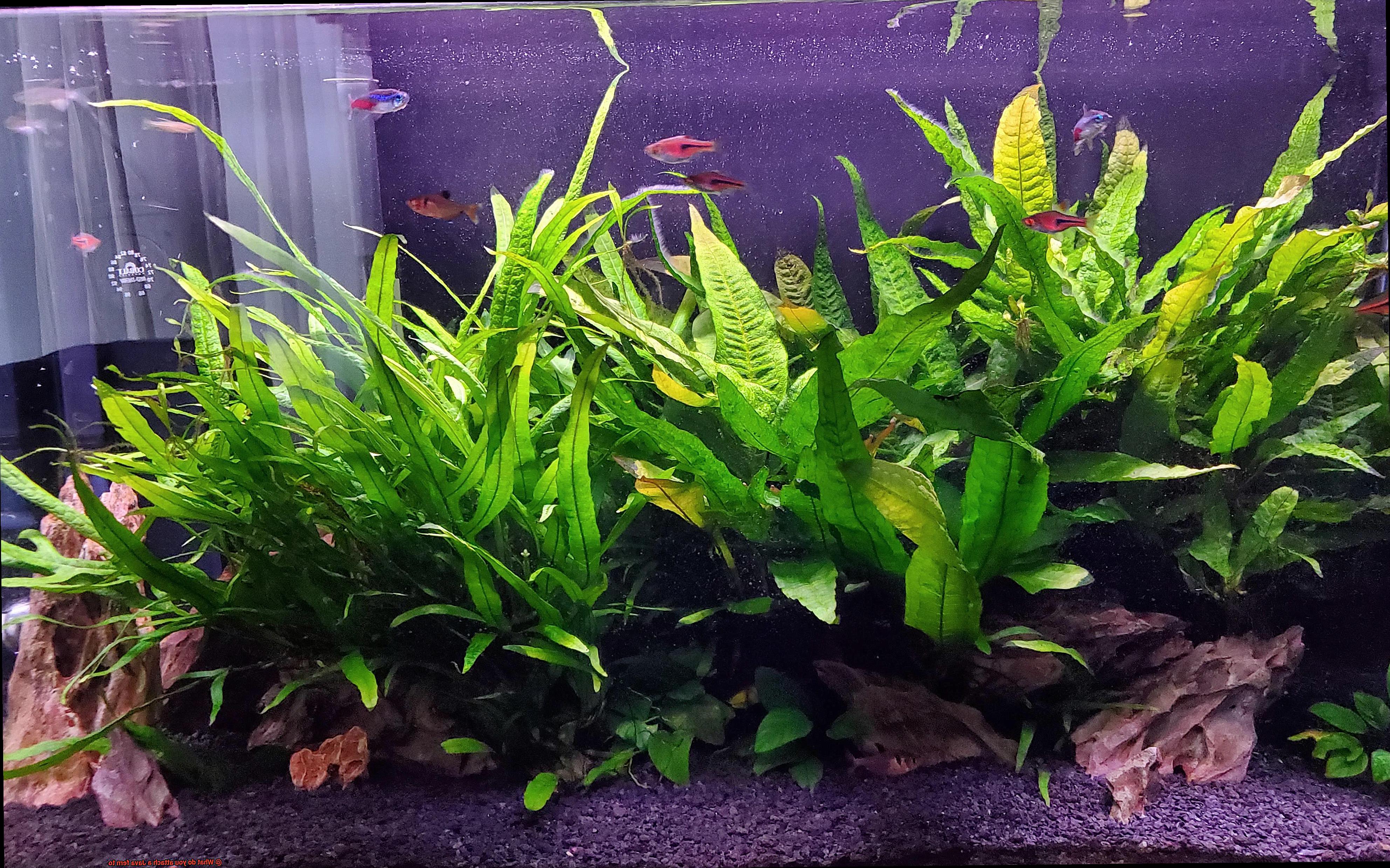
pH level:
- Choose a substrate that does not significantly alter the pH of the water in your aquarium or terrarium.
- Opt for substrates that maintain a stable pH or those specifically designed for aquatic plants.
- Java ferns prefer slightly acidic to neutral pH levels.
Aesthetics:
- Consider the overall aesthetics when choosing a substrate for your Java fern.
- Select a substrate that complements the appearance of the plant and enhances the visual appeal of your aquarium or terrarium.
- Options like black gravel, natural river rocks, or a combination of substrates can create a visually pleasing environment.
Benefits of Attaching Java Ferns
When it comes to creating an awe-inspiring underwater landscape in your aquarium, attaching Java ferns is a game-changer. These beautiful aquatic plants not only enhance the natural look of your tank but also offer a multitude of benefits for both your fish and the overall ecosystem.
The visual appeal of attaching Java ferns is undeniable. With their long, flowing leaves, these ferns create a lush and vibrant underwater scene that will make you feel like you’re diving into a tropical paradise. The dense foliage adds depth and texture to your tank, providing a visually pleasing environment for both you and your fish.
But the benefits don’t stop at aesthetics – Java ferns also provide practical advantages for your fish. The dense foliage of these plants offers additional hiding places, creating shelter and security for shy or territorial species. This can help reduce stress levels among the fish, promoting their overall health and well-being. So not only do Java ferns make your aquarium look amazing, but they also provide a safe haven for your aquatic friends.
In addition to their aesthetic and practical benefits, Java ferns play a crucial role in maintaining water quality. Like other aquatic plants, they absorb nitrates from the water, acting as natural filters. By reducing nitrate levels, Java ferns help prevent algae growth and create a healthier environment for fish and other inhabitants. So not only are you adding beauty to your tank, but you’re also ensuring a clean and balanced ecosystem.
But wait, there’s more. Attaching Java ferns to surfaces in your aquarium can also serve as a spawning site for certain species of fish. The plants provide a suitable substrate for fish to lay their eggs, helping to encourage successful breeding in captivity. This opens up new possibilities for aquarists who are interested in breeding their fish and adds another layer of excitement to your underwater world.
One of the great things about Java ferns is their compatibility with a wide range of water parameters. They can thrive in various conditions, including low light levels and fluctuating water temperatures. This versatility makes them an excellent choice for beginners or those who may not have ideal aquarium setups. So whether you’re a seasoned aquarist or just starting out, Java ferns are a fantastic option to consider.
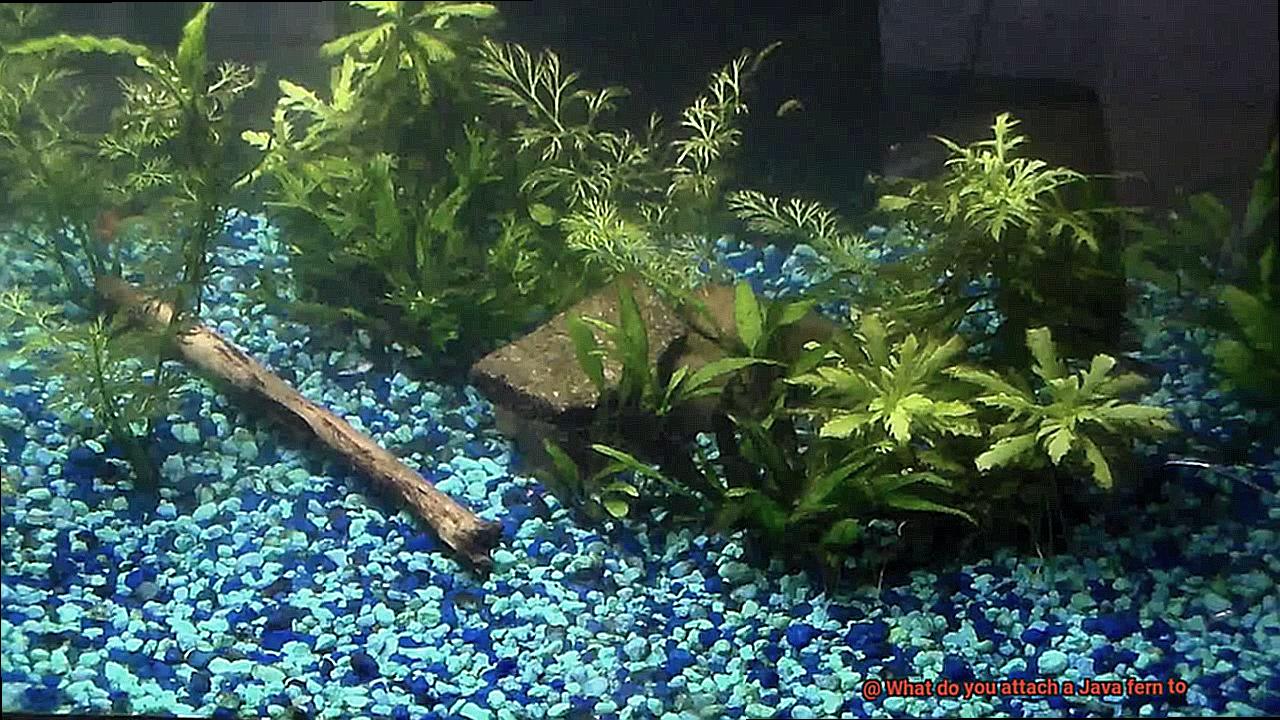
And here’s another perk – Java ferns are known for their ability to propagate easily. Once attached to a surface, they will develop rhizomes from which new plants can sprout. This means that over time, a single attachment can give rise to multiple Java ferns, allowing you to expand your plant collection without additional expenses. It’s like having a never-ending supply of beauty in your tank.
Last but not least, Java ferns are low-maintenance when it comes to fertilization. While they can benefit from occasional nutrient supplements, they can also extract essential elements from the water column and substrate. This makes them a hassle-free option for aquarists who prefer not to engage in complex fertilization routines.
Maintenance Tips for Java Ferns
Java ferns are stunning aquatic plants that effortlessly enhance the beauty of your aquarium. While they are known for their low-maintenance nature, providing them with proper care is essential for their long-term health and vibrancy. In this blog post, we will explore some simple maintenance tips that will keep your Java ferns thriving and adding a touch of natural beauty to your aquatic haven.
Choosing the Right Lighting:
Java ferns prefer moderate to low levels of light, making them perfect for aquariums with dimly lit areas. High-intensity lighting can harm their delicate leaves, leading to browning or burning. It’s crucial to provide them with the right amount of light to maintain their optimal health and appearance.
Ensuring Water Quality:
Clean water is vital for the well-being of your Java ferns. Regular water changes, around 10-20% each week, help remove toxins and pollutants, ensuring that your ferns have the best possible water conditions for growth. By maintaining excellent water quality, you provide a healthy environment for your Java ferns to flourish.
Nutrient-Rich Substrate:
While Java ferns can survive without a specialized substrate, using one that contains essential nutrients like iron and potassium promotes healthier growth and vibrant foliage. In addition to substrate, you can use root tabs or liquid fertilizers specifically designed for aquarium plants to provide the necessary nutrients that may be lacking in the water column. A nutrient-rich substrate ensures that your Java ferns receive the nourishment they need to thrive.
Ideal Temperature and pH Levels:
Java ferns are adaptable and can tolerate a wide range of temperatures (68-82°F or 20-28°C). They also thrive in slightly acidic to slightly alkaline conditions, with a pH range of 6.0-7.Maintaining the ideal temperature and pH levels in your aquarium ensures that your Java ferns remain healthy and vibrant.
Attaching Java Ferns:
Java ferns are epiphytic plants, meaning they naturally grow on other surfaces rather than being rooted in substrate. You can attach them to rocks, driftwood, or other decorations using fishing line or plant-safe glue. It’s important to secure the attachment gently but firmly, avoiding any damage to the plant. By providing a suitable surface for attachment, you allow your Java ferns to showcase their natural beauty in your aquarium.
Regular Pruning:
Pruning your Java ferns is essential to maintain their overall health and appearance. Trim off any yellow or decaying leaves using clean, sterilized scissors or aquatic plant trimming tools. By removing unhealthy foliage, you promote new growth and keep your Java ferns looking their best.
E-5RYr-dPU8″ >
Conclusion
When it comes to attaching a Java fern, there are a few options you can consider.
One popular choice is attaching it to driftwood. The long, elegant fronds of the Java fern can beautifully drape over the wood, creating a stunning focal point in your aquarium.
Another option is attaching it to rocks or stones. This not only provides stability for the plant but also adds an interesting texture and dimension to your tank.
If you prefer a more creative approach, you can even attach the Java fern to decorative items like ceramic ornaments or mesh panels. The possibilities are endless.
Just make sure whatever you choose is sturdy enough to support the plant and won’t harm its delicate roots.






